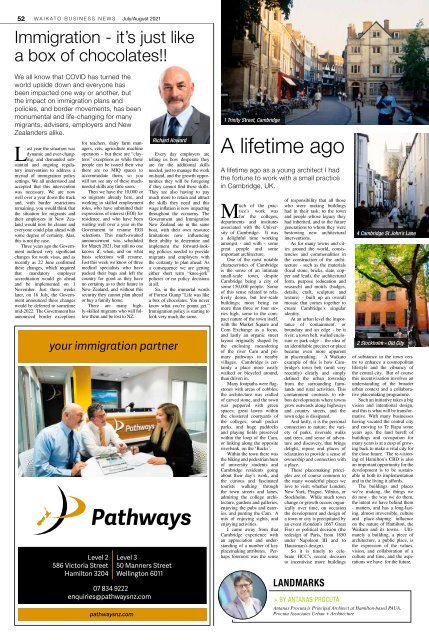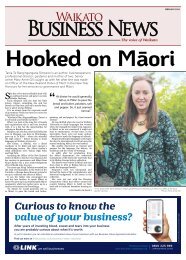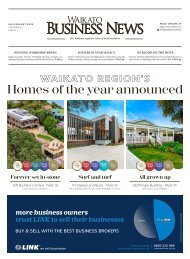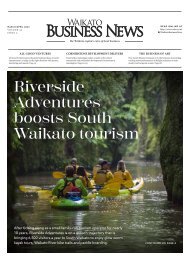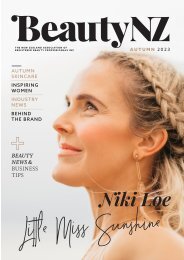Waikato Business News July/August 2021
Waikato Business News has for a quarter of a century been the voice of the region’s business community, a business community with a very real commitment to innovation and an ethos of co-operation.
Waikato Business News has for a quarter of a century been the voice of the region’s business community, a business community with a very real commitment to innovation and an ethos of co-operation.
Create successful ePaper yourself
Turn your PDF publications into a flip-book with our unique Google optimized e-Paper software.
52 WAIKATO BUSINESS NEWS <strong>July</strong>/<strong>August</strong> <strong>2021</strong><br />
Immigration - it’s just like<br />
a box of chocolates!!<br />
We all know that COVID has turned the<br />
world upside down and everyone has<br />
been impacted one way or another, but<br />
the impact on immigration plans and<br />
policies, and border movements, has been<br />
monumental and life-changing for many<br />
migrants, advisers, employers and New<br />
Zealanders alike.<br />
Last year the situation was<br />
dynamic and ever-changing,<br />
and demanded substantial<br />
and ongoing regulatory<br />
intervention to address a<br />
myriad of immigration policy<br />
settings. We all understood and<br />
accepted that this intervention<br />
was necessary. We are now<br />
well over a year down the track<br />
and, with border restrictions<br />
remaining, you would think that<br />
the situation for migrants and<br />
their employers in New Zealand<br />
would now be clearer and<br />
everyone could plan ahead with<br />
some degree of certainty. Alas,<br />
this is not the case.<br />
Three years ago the Government<br />
outlined very significant<br />
changes for work visas, and as<br />
recently as 22 June confirmed<br />
these changes, which required<br />
that mandatory employer<br />
accreditation would go ahead<br />
and be implemented on 1<br />
November. Just three weeks<br />
later, on 16 <strong>July</strong>, the Government<br />
announced these changes<br />
would be deferred to sometime<br />
mid-2022. The Government has<br />
announced border exceptions<br />
Level 2<br />
586 Victoria Street<br />
Hamilton 3204<br />
for teachers, dairy farm managers,<br />
vets, agriculture machine<br />
operators – but these are “claytons”<br />
exceptions as while these<br />
people can be issued their visa<br />
there are no MIQ spaces to<br />
accommodate them, so you<br />
will not see any of these muchneeded<br />
skills any time soon.<br />
Then we have the 10,000 or<br />
so migrants already here, and<br />
working in skilled employment<br />
roles, who have submitted their<br />
expressions of interest (EOI) for<br />
residence, and who have been<br />
waiting well over a year on the<br />
Government to resume EOI<br />
selections. This much-awaited<br />
announcement was scheduled<br />
for March <strong>2021</strong>, but still no one<br />
knows if, when, and on what<br />
basis selections will resume.<br />
Just this week we know of three<br />
medical specialists who have<br />
packed their bags and left the<br />
country for good as they have<br />
no certainty as to their future in<br />
New Zealand, and without this<br />
security they cannot plan ahead<br />
or buy a family home.<br />
There are many highly-skilled<br />
migrants who will follow<br />
them and be lost to NZ.<br />
Level 3<br />
50 Manners Street<br />
Wellington 6011<br />
07 834 9222<br />
enquiries@pathwaysnz.com<br />
pathwaysnz.com<br />
Richard Howard<br />
Every day employers are<br />
telling us how desperate they<br />
are for the additional skills<br />
needed, just to manage the work<br />
on-hand, and the growth opportunities<br />
they will be foregoing<br />
if they cannot find these skills.<br />
They are also having to pay<br />
much more to retain and attract<br />
the skills they need and this<br />
wage inflation is now impacting<br />
throughout the economy. The<br />
Government and Immigration<br />
New Zealand are in the same<br />
boat, with their own resource<br />
limitations now influencing<br />
their ability to determine and<br />
implement the forward-looking<br />
policies needed to provide<br />
migrants and employers with<br />
the certainty to plan ahead. As<br />
a consequence we are getting<br />
either short term “knee-jerk”<br />
policies or no policy decisions<br />
at all.<br />
So, in the immortal words<br />
of Forrest Gump “Life was like<br />
a box of chocolates. You never<br />
know what you’re gonna get.”<br />
Immigration policy is starting to<br />
look very much the same.<br />
1 Trinity Street, Cambridge<br />
A lifetime ago<br />
A lifetime ago as a young architect I had<br />
the fortune to work with a small practice<br />
in Cambridge, UK.<br />
Much of the practice’s<br />
work was<br />
for the colleges,<br />
departments and institutes<br />
associated with the University<br />
of Cambridge. It was<br />
a delightful time working<br />
amongst - and with - some<br />
great people and some<br />
important architecture.<br />
One of the most notable<br />
characteristics of Cambridge<br />
is the sense of an intimate<br />
small-scale town, despite<br />
Cambridge being a city of<br />
some 150,000 people. Some<br />
of this sense related to relatively<br />
dense, but low-scale<br />
buildings; most being no<br />
more than three or four stories<br />
high, some to the compact<br />
nature of the town itself,<br />
with the Market Square and<br />
Corn Exchange as a focus,<br />
and lastly an organic street<br />
layout originally shaped by<br />
the enclosing meandering<br />
of the river Cam and primary<br />
pathways to nearby<br />
villages. Cambridge is certainly<br />
a place more easily<br />
walked or bicycled around,<br />
than driven in.<br />
Many footpaths were flagstones<br />
with areas of cobbles,<br />
the architecture was crafted<br />
of carved stone, and the town<br />
was peppered with green<br />
spaces; great lawns within<br />
the cloistered courtyards of<br />
the colleges, small pocket<br />
parks, and huge paddocks<br />
and playing fields preserved<br />
within the loop of the Cam,<br />
or linking along the opposite<br />
riverbank, on the ‘Backs’.<br />
Within the town there was<br />
the biking and pedestrian hum<br />
of university students and<br />
Cambridge residents going<br />
about their day’s work, and<br />
the curious and fascinated<br />
tourists walking through<br />
the town streets and lanes,<br />
admiring the college architecture,<br />
gardens and galleries,<br />
enjoying the pubs and eateries,<br />
and punting the Cam. A<br />
mix of enjoying sights, and<br />
enjoying activities.<br />
I came away from that<br />
Cambridge experience with<br />
an appreciation and understanding<br />
of a number of key<br />
placemaking attributes. Perhaps<br />
foremost was the sense<br />
of responsibility that all those<br />
who were making buildings<br />
had in their task; to the town<br />
and people whose legacy they<br />
had inherited, and to the future<br />
generations to whom they were<br />
bestowing new architectural<br />
interventions.<br />
As for many towns and cities<br />
around the world, consistencies<br />
and commonalities in<br />
the construction of the architecture<br />
- such as the materials<br />
(local stone, bricks, slate, copper<br />
and lead), the architectural<br />
form, purpose (education and<br />
research) and motifs (badges,<br />
details, craft, sculpture and<br />
texture) - built up an overall<br />
mosaic that comes together to<br />
create Cambridge’s singular<br />
identity.<br />
At an urban level the importance<br />
of 'containment', or<br />
boundary and an edge - be it<br />
river, a town belt, walled enclosure<br />
or park edge - the idea of<br />
an identifiable precinct or place<br />
became even more apparent<br />
in placemaking. A <strong>Waikato</strong><br />
example of this is how Cambridge's<br />
town belt (until very<br />
recently) clearly and simply<br />
defined the urban township<br />
from the surrounding farmlands<br />
and rural activities. This<br />
containment contrasts to ribbon<br />
developments where towns<br />
grow outwards along highways<br />
and country streets, and the<br />
town edge is dissipated.<br />
And lastly, it is the personal<br />
connection to nature; the variety<br />
of parks, riverside walks<br />
and trees, and sense of adventure<br />
and discovery, that brings<br />
delight, repose and places of<br />
relaxation to provide a sense of<br />
ownership and connection with<br />
a place.<br />
These placemaking principles<br />
are of course common to<br />
the many wonderful places we<br />
love to visit; whether London,<br />
New York, Prague, Vilnius, or<br />
Stockholm. While much town<br />
change or growth occurs organically<br />
over time, on occasion<br />
the development and design of<br />
a town or city is precipitated by<br />
an event (London's 1667 Great<br />
Fire) or political decision (the<br />
redesign of Paris, from 1850<br />
under Napoleon III and to<br />
Haussman's design).<br />
So it is timely to celebrate<br />
HCC’s recent decision<br />
to incentivise more buildings<br />
LANDMARKS<br />
> BY ANTANAS PROCUTA<br />
4 Cambridge St John’s Lane<br />
2 Stockholm - Old City<br />
of substance in the town centre<br />
to enhance a cosmopolitan<br />
lifestyle and the vibrancy of<br />
the central city. But of course<br />
this incentivisation involves an<br />
understanding of the broader<br />
urban context and a collaborative<br />
placemaking programme.<br />
Such an initiative takes a big<br />
vision and intentional design,<br />
and this is what will be transformative.<br />
With many businesses<br />
having vacated the central city<br />
and moving to Te Rapa some<br />
years ago, the land bereft of<br />
buildings and occupation for<br />
many years is at a cusp of growing<br />
back to make a vital city for<br />
the close future. The re-visioning<br />
of Hamilton’s CBD is also<br />
an important opportunity for the<br />
development is to be sustainable<br />
in both its implementation<br />
and in the living it affords.<br />
The buildings and places<br />
we’re making, the things we<br />
do now - the way we do them,<br />
the intent we have behind them<br />
- matters, and has a long-lasting,<br />
almost irreversible, culture<br />
and place-shaping influence<br />
on the nature of Hamilton, the<br />
<strong>Waikato</strong> and its towns. Ultimately<br />
a building, a piece of<br />
architecture, a public place, is<br />
the expression of the values,<br />
vision, and collaboration of a<br />
culture and time, and the aspirations<br />
we have for the future.<br />
Antanas Procuta is Principal Architect at Hamilton-based PAUA,<br />
Procuta Associates Urban + Architecture


